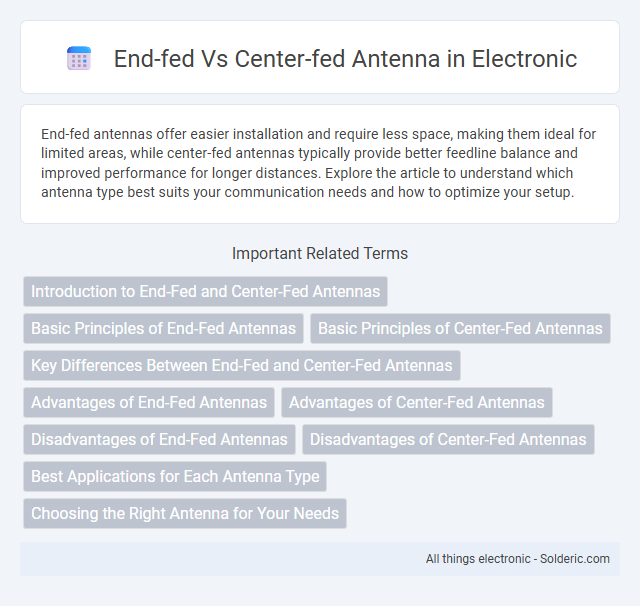End-fed antennas offer easier installation and require less space, making them ideal for limited areas, while center-fed antennas typically provide better feedline balance and improved performance for longer distances. Explore the article to understand which antenna type best suits your communication needs and how to optimize your setup.
Comparison Table
| Feature | End-Fed Antenna | Center-Fed Antenna |
|---|---|---|
| Feed Point | At one end of the antenna element | At the middle of the antenna element |
| Impedance | High impedance, often requires impedance matching | Typically 50-100 ohms, easier to match |
| Installation | Simple, fewer supports needed | Requires center support for feedpoint |
| Feedline Type | Coaxial cable directly connected | Balanced feedline such as ladder line or coax with balun |
| Radiation Pattern | Asymmetric pattern, may have higher radiation at feed end | Symmetric pattern with broadside radiation |
| Bandwidth | Narrower bandwidth | Wider bandwidth |
| Typical Use | Portable, limited space installations | Base stations, repeaters, general purpose |
| Matching Devices | Tuner or transformer (e.g., 49:1 UNUN) | Balun (e.g., 1:1 or 4:1) often used |
| Cost | Generally lower cost and simpler hardware | Potentially higher cost due to feedline and supports |
Introduction to End-Fed and Center-Fed Antennas
End-fed antennas are connected to the transmitter at one end, featuring simpler installation and often requiring a counterpoise for effective operation, making them popular for portable and limited-space setups. Center-fed antennas have a feed point at the center, providing symmetrical current distribution and typically offering better impedance matching and efficiency for longer, fixed installations. Your choice depends on the specific application, space availability, and performance needs, with center-fed designs favored for balanced, high-performance systems and end-fed suited for convenience and simplicity.
Basic Principles of End-Fed Antennas
End-fed antennas operate by connecting the feedline at one end of the antenna wire, relying on the antenna's natural resonance and impedance transformation to achieve efficient radiation. They typically require a matching network or counterpoise to ensure proper current distribution and minimize losses. Understanding these basic principles helps you optimize your antenna setup for effective transmission and reception in various amateur radio applications.
Basic Principles of Center-Fed Antennas
Center-fed antennas operate by feeding the antenna element at its midpoint, resulting in a balanced current distribution that maximizes radiation efficiency. This design minimizes impedance mismatch and reduces signal loss, making it ideal for HF and VHF applications. Your communication system benefits from improved bandwidth and consistent radiation patterns due to the symmetrical feed point.
Key Differences Between End-Fed and Center-Fed Antennas
End-fed antennas are fed at one end and typically require a counterpoise or ground system to function effectively, while center-fed antennas are fed at the center and generally have balanced radiation patterns and impedance. End-fed antennas tend to be more compact and easier to install in limited spaces, making them suitable for portable or stealth operations, whereas center-fed antennas offer better power handling and efficiency for fixed installations. Your choice depends on installation constraints, desired radiation characteristics, and operating frequency bands.
Advantages of End-Fed Antennas
End-fed antennas offer the advantage of easier installation in limited space, requiring only a single support point, making them ideal for portable or stealth operations. Their simplicity reduces the need for extensive ground radials or multiple feedlines, enhancing efficiency in urban or restricted environments. You benefit from minimal tuning complexity and versatile deployment options, especially in narrow or irregular terrain.
Advantages of Center-Fed Antennas
Center-fed antennas offer balanced current distribution, resulting in improved radiation efficiency and a more symmetrical radiation pattern. Their feedpoint impedance typically matches standard transmission lines, minimizing signal loss and simplifying antenna tuning. These characteristics make center-fed antennas ideal for consistent performance in various HF and VHF applications.
Disadvantages of End-Fed Antennas
End-fed antennas often suffer from high impedance at the feed point, requiring complex matching networks that can lead to power loss and reduced efficiency. They tend to produce higher levels of common-mode current, causing increased radio frequency interference (RFI) and noise in nearby electronics. Signal radiation patterns may be less predictable compared to center-fed antennas, resulting in inconsistent performance across different operating frequencies.
Disadvantages of Center-Fed Antennas
Center-fed antennas often require complex feedline arrangements and baluns to ensure proper impedance matching, which can increase the overall system cost and installation difficulty. Their balanced feed system may be more susceptible to grounding issues and interference, potentially affecting signal clarity. You might find end-fed antennas more straightforward to set up when convenience and reduced hardware complexity are priorities.
Best Applications for Each Antenna Type
End-fed antennas excel in portable and stealth operations due to their simple deployment and minimal ground requirements, making them suitable for field or emergency setups. Center-fed antennas offer superior impedance matching and balanced radiation patterns, ideal for fixed installations and amateur radio stations seeking efficient multi-band performance. Your choice depends on mobility needs and installation complexity, with end-fed favoring convenience and center-fed prioritizing optimal signal quality.
Choosing the Right Antenna for Your Needs
End-fed antennas offer simplicity and easy installation, making them ideal for portable or limited-space setups, while center-fed antennas provide balanced feed points that enhance radiation efficiency and bandwidth for fixed, performance-focused applications. Choosing between end-fed and center-fed antennas depends on factors such as available space, frequency range, and desired signal quality. Prioritize your operating environment, equipment compatibility, and antenna support requirements to select the best solution tailored to your communication goals.
end-fed vs center-fed antenna Infographic

 solderic.com
solderic.com